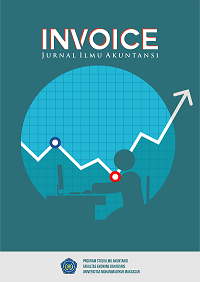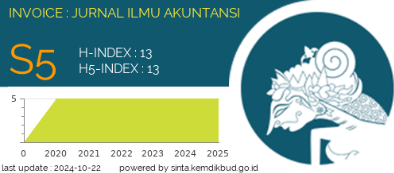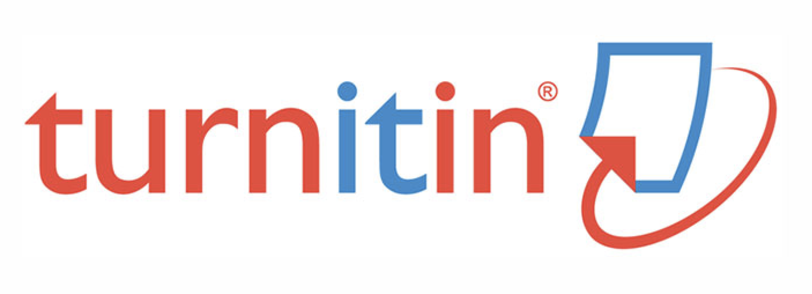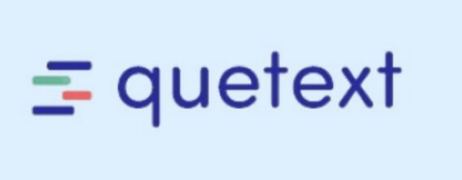PENGARUH STRUCTURE OWNERSHIP DAN KARAKTERISTIK AUDITOR TERHADAP TAX AVOIDANCE PADA PERUSAHAAN DALAM IDXV30 DI BURSA EFEK INDONESIA
DOI: https://doi.org/10.26618/inv.v2i1.3189
Abstract
This study aims to determine the effect of Structure Onwership and Auditor Characteristics on Tax Avoidance in IDXV30 on the Indonesia Stock Exchange. This study uses a quantitative method with the acquisition and secondary data collection. The companies that became the sample of this study were 30 companies that applied accounting conservatism. The number of samples that could be analyzed were 30 samples, thus the number of samples over three years was 90 samples (30x3). The results of the X1 Variable Test (Structure Ownership) gave a parameter coefficient (t-count) of 1,809 with a significance level of 0.07 (<0.10). This means that H1 is accepted (Hair, 2017) so it can be said that Structure Ownership has a positive and significant effect on Tax Avoidance Variable X2 (Characteristics of Auditors) giving a parameter coefficient value of 0.02 (<0.05). This means that H1 is accepted so that it can be said that the auditor's characteristics have a significant and significant effect on tax avoidance because the level of significance possessed by the auditor's variable characteristics <0.05 (0.02> 0.05) and tcount> 1.668 (2,347> 1,668).
References
Agus. (2015, August Monday). Karakteristi Auditor. Retrieved from www.coursehero.com:https://www.coursehero.com/file/pr0jl1/4-Karakteristik-Kriteria-Audit-Karakteristik-kriteria-yang-baik-mencakup-hal/
Alit., I. G. (2014). Pengaruh Corporate Governance, Profitabilitas dan Karakteristik Eksekutif Pada Tax Avoidance Perusahaan Manufaktur. . EJurnal Akuntansi Universitas Udayana. Vol. 9. No. 2, 16-31.
Ariani. (2012). Karakteristik Komite Audit, Eksternal Auditor, dan Audit Report Lag. Proceeding Seminar Nasional Hasil Penelitian STIE.
Ariany. (2012). Karakteristik Komite Audit, Eksternal Auditor, dan Audit Report Lag. Proceeding Seminar Nasional Hasil Penelitian STIE.
Bagus. (2010). The International Tax Compact. Retrieved from www.ajarekonomi.com: htps://www.ajarekonomi.com/2015/12/memahami-tax-evasion-dan-tax-avoidance.html
Bambang Supomo, d. I. (2009). Metodologi Penelitian Bisnis untuk Akuntansi dan Manajemen, (Pertama ed.). Yogyakarta: BPFE.
Budiman, J. &. (2012). Pengaruh Karakter Eksekutif terhadap Penghindaran Pajak (Tax Avoidance). 43.
Darwis. (2012). Pengaruh Structure Ownership dan Karaktersitik dalam Kepemilikan Instutusional, Kepemilikan Manajerial terhadap Tax Avoidance. Economic and Bussiness, 60-68.
Ghozali, I. (2011). “Aplikasi Analisis Multivariate Dengan Program SPSS”. Semarang: Badan Penerbit Universitas Diponegoro. .
Herdiyanto, D. G. (2015). Pengaruh Tax Avoidance Terhadap Nilai Perusahaan. . Diponegoro Journal Of Accounting. Volume 4, Nomor 3, 1-10.
IAI. (2001). Standar Profesional Akuntan Publik. Jakarta: Ikatan Akuntan Indonesia (IAI).
Indrayagus. (2009). Tax Planning, Tax Avoidance, dan Tax Evasion di Mata Perpajakan Indonesia. In Inside Tax (p. 8). Jakarta.
Jensen, M. a. (1976.). “Theory of Firm: Managerial Behaviour, Agency Cost and Ownership Structure". pp. pp. 305-360.
Kemenkeu. (2017, September 3). Diambil kembali dari https://www.kemenkeu.go.id: https://www.kemenkeu.go.id/publikasi/berita/wamenkeu-informasikeuangan-penting-untuk-tingkatkankepatuhan-membayar-pajak/
KNKG. (2006). Pedoman Umum Good Corporate Governance Indonesia. Jakarta.
Kurniasih, T. &. (2013). Pengaruh Return On Assets,Leverage, Corporate Governance, Ukuran Perusahaan Dan Kompensasi Rugi Fiskal Pada Tax Avoidance. . Buletin Studi Ekonomi, Volume 18, No. 1, .
Ninik. (2017). Pengaruh Fee Audit, Audit Tenure, Rotasi Audit dan Reputasi Auditor Terhadap Kualitas Audit di Kantor Akuntan Publik. Ekonomi dan Bisnis.
Nugraha, R. A. (2019). “Pengaruh Corporate Ownership, Karakteristik Eksekutif Dan Intensitas Aset Tetap Terhadap Tax Avoidance. 60-65.
Nurul Mutmainnah, R. W. (2013). Nurul Mutmainnah, Ratna Wardhani. Jurnal Akuntansi dan Keuangan Indonesia, Vol 10, No 2 (2013), 40-50.
Oktaviyani, R. a. (2017). Effect of Solvency, Sales Growth, and Institutional Ownership on Tax Avoidance with Profitability as Moderating Variables in Indonesian Property and Real Estate Companies. . Binus Business Review, , 183-188.
Paulus, M. (2007). Categorizing International Tax Planning. Fundamentals of International Tax Planning. IBFD, 66-69.
Pengaruh Corporate Governance, Profitabilitas dan Karakteristik Eksekutif Pada Tax Avoidance Perusahaan Manufaktur. (2014). Jurnal Akuntansi Universitas Udayana. Vol. 9. No. 2. , 16-31.
Siagian, G. d. (2011). Agency Teory. Economic and Business.
Siregar, S. V. (2005). Pengaruh Struktur Kepemilikan. Ukuran Perusahaan.
Sudana, I. M. (2011). Manajemen Keuangan Perusahaan. Jakarta: Erlangga.
Sugiyono. (2015). Metode Penelitian Kombinasi (Mix Methods). Bandung : Alfabeta.
Suharto. (2015). Agency Theory dalam prinsip manajer. Yogyakarta: Salemba Empat.
Sukirni, D. (2012). Kepemilikan Manajerial, Kepemilikan Institusional, Kebijakan Dividen dan Kebijakan Hutang Analisis terhadap Nilai Perusahaan. . Accounting Analysis Journal. Vol. 1, No. 2, 1-12.
Wahab. (2012). Determinants of capital structure of Malaysian property developers. Journal of Scientific Research, 8, 1013-1021.
Winata, F. (2014). Pengaruh Corporate Governance Terhadap Tax Avoidance pada Perusahaan yang Terdaftar di Bursa Efek Indonesia Tahun 2013. Tax dan Accounting Review. Vol. 4. No. 1. , 1-11.
Yasser. (2017). Corporate Social Responsibility and Gender Diversity: Insights from Asia Pacific: Gender Diversity, Corporate Social Responsibility. Corporate Social and Enviromental Management, 3, 143.
Yasser, Q. M. (2017). The Impact of ownership structure on financial reporting quality in the East. International Journal of Organizational Analysis, 25.
Downloads
Published
Issue
Section
License
Authors who publish with Invoice: Jurnal Ilmu Akuntansi agree to the following terms:
-
Copyright Ownership
The copyright of all articles published in this journal remains with the author(s). However, the authors grant Invoice: Jurnal Ilmu Akuntansi the right of first publication with the work simultaneously licensed under a Creative Commons Attribution 4.0 International License (CC BY 4.0). This license allows others to share, copy, redistribute, adapt, and build upon the work for any purpose, even commercially, as long as proper credit is given to the original author(s) and the source. -
Licensing and Access
Invoice: Jurnal Ilmu Akuntansi provides immediate open access to its content on the principle that making research freely available to the public supports a greater global exchange of knowledge. All published materials are available freely without subscription or payment and can be accessed, downloaded, and reused by any user provided that appropriate attribution is given. -
Permission for Reuse
For uses not covered by the CC BY 4.0 license, such as commercial reprints, translations, or any form of adaptation without clear attribution, users must obtain written permission from the editorial team. Requests for such permissions can be directed to the editorial office at: [invoice@unismuh.ac.id]. -
Plagiarism and Originality
Authors are responsible for the originality of their submissions. All articles are screened for plagiarism using appropriate tools before acceptance. Manuscripts found to contain unoriginal content or infringing materials will be rejected or retracted as per journal policy.














